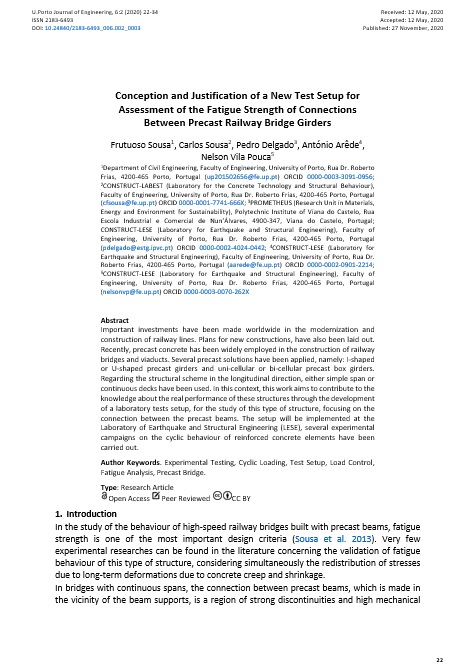Conception and Justification of a New Test Setup for Assessment of the Fatigue Strength of Connections Between Precast Railway Bridge Girders
Main Article Content
Abstract
Important investments have been made worldwide in the modernization and construction of railway lines. Plans for new constructions have also been laid out. Recently, precast concrete has been widely employed in the construction of railway bridges and viaducts. Several precast solutions have been applied, namely: I-shaped or U-shaped precast girders and uni-cellular or bi-cellular precast box girders. Regarding the structural scheme in the longitudinal direction, either simple span or continuous decks have been used. In this context, this work aims to contribute to the knowledge about the real performance of these structures through the development of a laboratory tests setup, for the study of this type of structure, focusing on the connection between the precast beams. The setup will be implemented at the Laboratory of Earthquake and Structural Engineering (LESE), several experimental campaigns on the cyclic behaviour of reinforced concrete elements have been carried out.
Downloads
Article Details
Authors who publish with this journal agree to the following terms:
- Authors retain copyright and grant the journal right of first publication with the work simultaneously licensed under a Creative Commons Attribution License that allows others to share the work with an acknowledgement of the work's authorship and initial publication in this journal.
- Authors grant the journal the rights to provide the article in all forms and media so the article can be used on the latest technology even after publication and ensure its long-term preservation.
- Authors are able to enter into separate, additional contractual arrangements for the non-exclusive distribution of the journal's published version of the work (e.g., post it to an institutional repository or publish it in a book), with an acknowledgement of its initial publication in this journal.
- Authors are permitted and encouraged to post their work online (e.g., in institutional repositories or on their website) prior to and during the submission process, as it can lead to productive exchanges, as well as earlier and greater citation of published work (See The Effect of Open Access).

